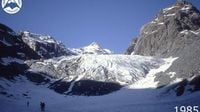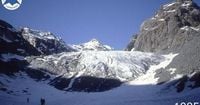Italy’s Ventina glacier, once a proud giant of northern Lombardy, has reached a somber milestone that scientists hoped they’d never witness. On August 19, 2025, geologists announced that the glacier has melted so extensively due to climate change that traditional methods of measuring its retreat—used consistently for the past 130 years—are now impossible. The news, reported by outlets including ABC and the Associated Press, signals not just a local loss, but a vivid warning of global environmental change.
“While we could still hope until the 1980s that there would be normal cycles (of retraction) or at least a contained retraction, in the last 40 years something truly striking has occurred,” said Andrea Toffaletti, a member of the Lombardy Glaciological Service, as quoted by the Australian Associated Press. For generations, scientists would trek to the glacier, near Sondrio in northeast Lombardy, each year to drive simple stakes into the ice. These benchmarks allowed them to chart the glacier’s slow but steady retreat—a kind of annual health check for the ancient ice.
But after the blistering summer of 2025, those stakes are now lost beneath rockslides and debris. The terrain, once accessible, has become too unstable for safe passage. The Lombardy Glaciological Service, in a statement released on August 18, 2025, confirmed that “it will now use drone imagery and remote sensing to monitor the ongoing shrinkage of the glacier.” This pivot to technology marks the end of an era of direct, boots-on-the-ice research—a poignant shift for those who have spent their careers walking the glacier’s surface.
The numbers are as stark as the landscape itself. According to the Lombardy Glaciological Service, the Ventina glacier has lost 1.7 kilometers (or about one mile) in length since the first benchmarks were placed at its snout in 1895. Most alarming, the pace of melting has quickened: 431 meters (471 yards) have vanished in the past 10 years, with nearly half of that loss occurring since 2021. These figures, reported by both ABC and The Independent, put the Ventina glacier’s fate into sharp relief—and it’s a story echoed by glaciers across Europe.
Toffaletti, reflecting on the glacier’s decline, explained that the region’s mountain glaciers—spread throughout the Alps, Dolomites, and Apennines—have been receding for years. The culprits? Inadequate snowfall during increasingly mild winters and record-breaking hot summers. “Glaciers always melt some in summer, with the runoff fueling mountain streams and rivers,” Toffaletti told The Independent. “But the hot summers are no longer able to guarantee the survival of the winter snowpack that keeps the glacier intact.”
That snowpack, which once lingered atop the glacier each year, is now a vanishing rarity. “In order to regenerate and remain in balance, a certain amount of residual snow from the winter must remain on the glacier’s surface at the end of the summer. And this is happening less and less frequently,” Toffaletti added.
The Ventina glacier’s fate is not an isolated tragedy. The Alps themselves have become a climate hotspot, warming at twice the global average since pre-industrial times. This rapid temperature rise has contributed to the loss of over 64% of the volume of Alpine glaciers, as highlighted by the Lombardy Glaciological Service and reported by ABC and The Independent. The consequences ripple far beyond the loss of scenic beauty: shrinking glaciers mean less meltwater for rivers, disruptions to local ecosystems, and greater risk of natural hazards like landslides and floods.
For the Ventina glacier, the shift to remote monitoring is both a technical necessity and a symbol of loss. Drone imagery and satellite data will now provide the only reliable means of tracking its ongoing retreat. While these methods offer precision and safety, they cannot replace the tactile experience of standing on the glacier’s surface—a reality mourned by many in the scientific community.
Yet the story of Ventina is also a microcosm of a much larger, accelerating global trend. In February 2025, the journal Nature reported a sobering study: the world’s glaciers lost ice at a rate of about 231 billion metric tons annually from 2000 to 2011. Over the following decade, that rate jumped to approximately 314 billion metric tons per year. The numbers are almost too large to fathom, but their impact is unmistakable—rising sea levels, altered weather patterns, and threats to water supplies for millions.
Images comparing the Ventina glacier’s appearance in 1985, 2009, and August 2025, published by The Independent and the Associated Press, show a dramatic transformation. What was once a broad, gleaming expanse of ice has become a shrunken, debris-strewn remnant. The benchmarks—once visible, sturdy markers of scientific progress—are now buried, as if nature herself is erasing the evidence of what once was.
The loss of the Ventina glacier’s accessibility is particularly poignant given its location. The general area of northeast Lombardy, near Sondrio, is set to host some events for the 2026 Winter Olympics. The irony is hard to miss: as the world prepares to celebrate winter sports, one of the region’s most iconic glaciers is disappearing before our eyes. It’s a visual and scientific reminder of the stakes involved in the fight against climate change.
Scientists and environmentalists are sounding the alarm, urging action to slow the pace of warming and preserve what remains of the world’s glaciers. The Ventina glacier’s story is a warning—a testament to the speed and scale of change that’s possible when global temperatures rise. The Alps, with their double-the-global-average warming, are the canary in the coal mine, showing us what’s at risk if the world fails to act.
For now, geologists will rely on drones and satellites to watch over the Ventina glacier, documenting its final chapters from afar. The hope, slim as it may be, is that telling these stories—grounded in data, images, and the voices of those who know the glacier best—will spur the kind of action needed to protect the world’s remaining ice. The stakes, quite literally, have never been higher.
As the sun sets over Lombardy’s mountains, the Ventina glacier stands as both a monument to the past and a warning for the future—a silent, shrinking witness to a world in rapid transition.

